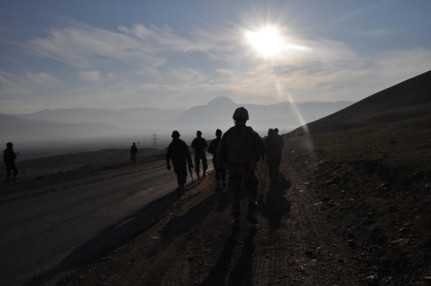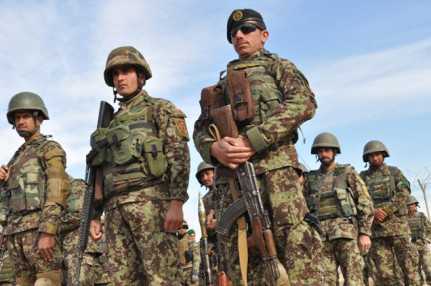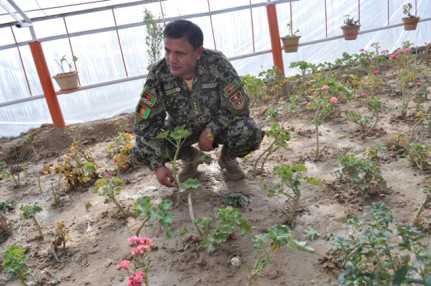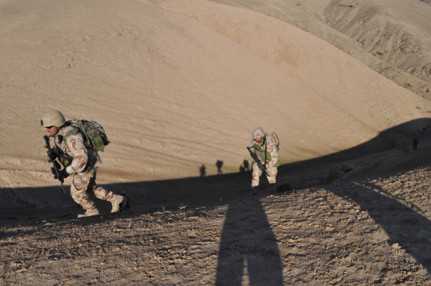At the Foot of the Hesco Bastions
Szöveg: Anikó Farkas | 2012. december 26. 6:00While paying a call on Col. Janullah Safi, battalion commander, the rules of behavior do not cause problems any more – we take the food being offered to us only with our left hand, and drink tea only on the handle side or the opposite side of the cup. ‘”The relationship between the Afghan and ISAF troops during training and operations is very good”, the colonel tells us…(Report from Afghanistan).

After several hours of uncomfortable bumping that have passed quickly thanks to the novelty of radio contact, and a supper taken in the by now familiar Pol-e Khomri, we arrive at Khilagay base. It soon turns out that “black-out" should be taken here even more seriously than in those other military camps we have been to during our journey so far. The commander warns our team right away – as we are getting out the MRAP vehicles – that the light has been too much, so let us go inside.
It seems that even flashlights might cause problems, so we are heading towards the living quarters almost in pitch dark. We can see only next morning that it is closely surrounded by Hesco bastions. It is not an unnecessary precaution here on the base of the Operational Mentoring and Liaison Team (OMLT), as multiple rocket attacks have been carried out against it over the last few months, and even the Afghan containerized housing units – that are located some hundred meters away in the camp – could be causes for worry. True, the soldiers here tell us that the chances of a “green on blue" attack are slight because it would deprive the battalion of a serious amount of support and protection as well as the prestige of the best-trained unit in the northern corps of the Afghan National Army (ANA).

Composed of American and Hungarian soldiers, the eight rotations of the OMLT have had so far the main mission of training, preparing and operationally mentoring the close to 1,000-strong ANA battalion (kandak) which is responsible for maintaining law and order in 14 districts of Baghlan Province. Now, after the battalion was declared capable of independent operations this summer, the tasks of the team is changing in line with the ISAF strategy too, so it is transitioning to an advisory role, and in December, its designation officially changed to Military Advisory Team (MAT).
Lt.-Col. Szabolcs Pécsvárady, the commander of the last OMLT and the first MAT, tells us that the battalion has really made a lot of progress over the last years thanks to the assistance and hard work done by the Hungarian and American mentors. Next day, on a joint patrol exercise we had an opportunity to see that the Afghan troops are already proficient at their job – but let’s not fast-forward for now…
While paying a call on Col. Janullah Safi, the commander of the battalion, the rules of behavior do not cause problems any more – we take the food being offered to us only with our left hand, and drink tea only on the handle side or the opposite side of the cup. Among other things, Lt.-Col. Pécsvárady warned us in advance that we should not ask Col. Safi about the Christmas tree decorating the office. Finally, the topic pops up and the colonel says he put the tree there for the American and Hungarian mentors’ sake, since Christmas is an important holiday to them.

The colonel is apparently grateful to the training and mentor team, and his statement that their results are credited to the OMLT also seems sincere. He is convinced that they would be able to maintain law and order and protect themselves in their area of responsibility after the withdrawal of ISAF too. He adds that he has been here for three years now, and in his opinion, the relationship between the Afghan and ISAF soldiers is very good during trainings and operations. When the Chief of the Defence Staff recently visited the base, he suggested that the Hungarian soldiers should get a pay rise.
By the time we end our conversation, the first company has just finished their training session for the day, so Col. Safi’s deputy shows us around the camp (see our photo gallery). Next morning, however, we have an opportunity to see the company (commanded by an English-speaking Afghan officer) in action. We set out on a 10-kilometer foot patrol – apart from patrolling, its objectives are to engage in conversation with the local people and to inspect the potential launch site of the latest rocket attack.
In the morning we start off with a briefing before the march, part of which is incomprehensible even to the more trained civilian ears; anyway, it is clear that the body armor and the helmet will be heavy and hot to wear, that we must drink during the march, and that we are advised to keep the designated force protection soldier in sight – he will not lose sight of us, of course.

Without divulging military secrets: we were marching on and beside the road, uphill and up the mountainside, then down and back along the edge of the village. The troops of the Afghan battalion provided the forward and rear security squads, and they did a good job in conducting reconnaissance on the move as well.
With the end of our foot patrol, we safely returned to the camp, then after taking a meal, some of us set out on another journey, while others took a rest. It is certain, however, that we have completed another successful mission in the theatre of war in Afghanistan, where currently around 500 Hungarian soldiers are serving, while others are waiting for their return home right before Christmas with the rotation of the contingents.
Photos by the author